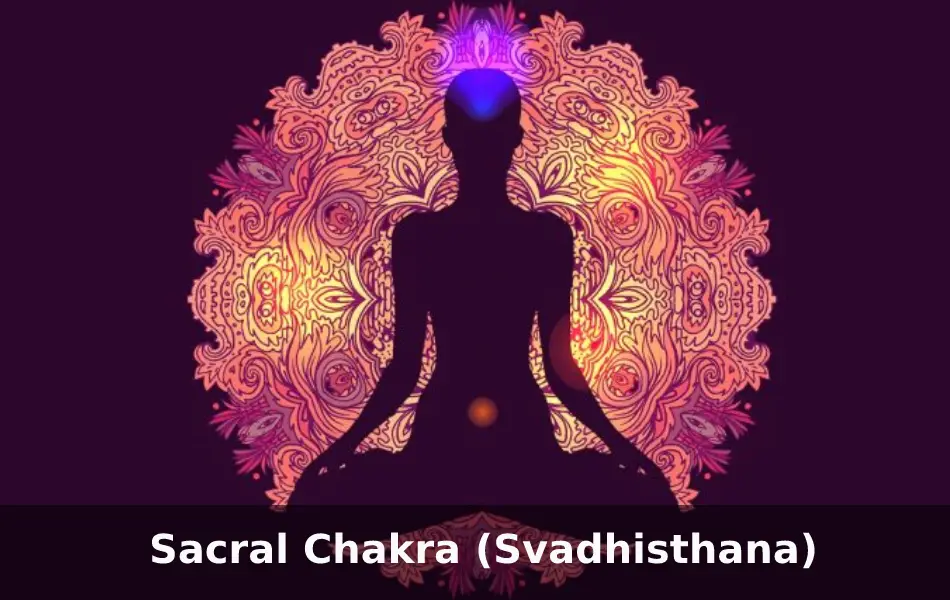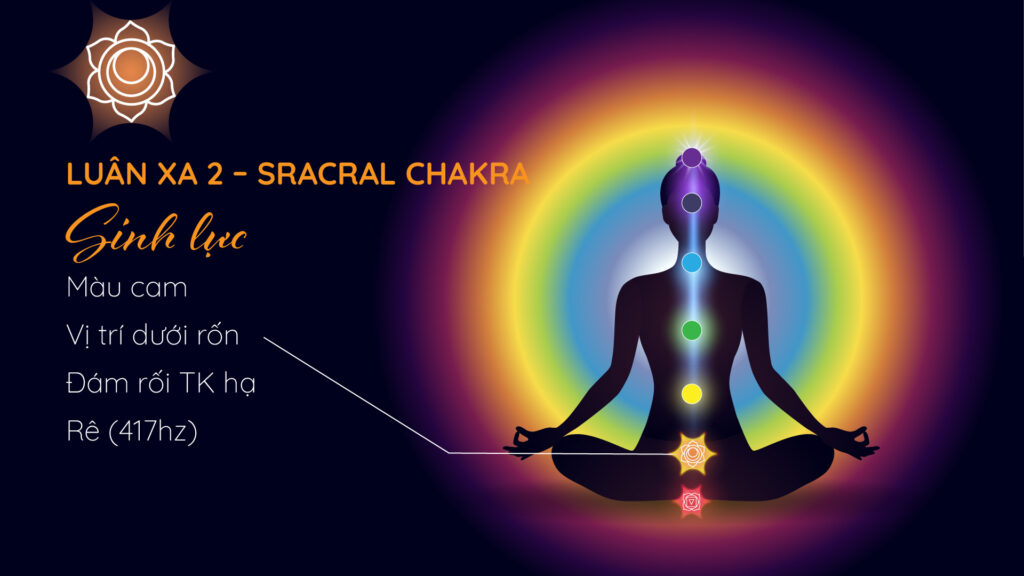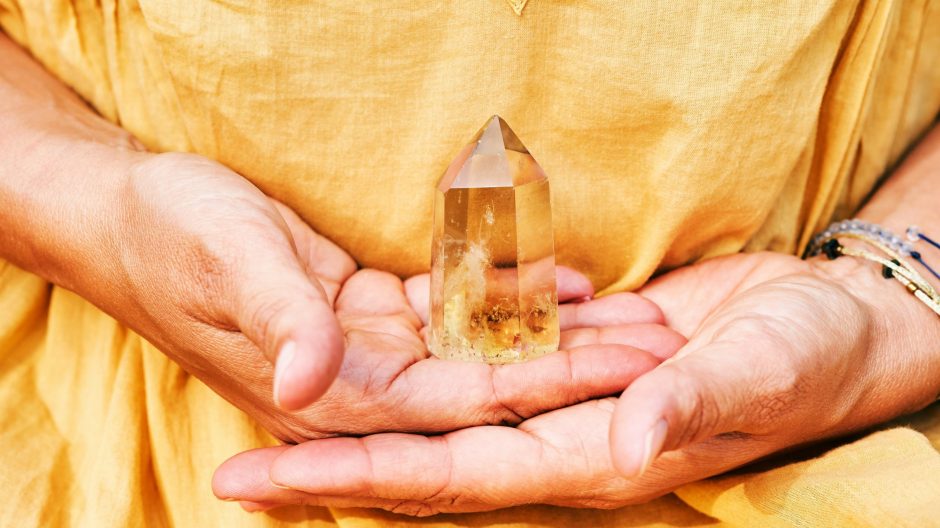The Sacral Chakra is a radiant vortex of energy situated just below your navel. It is the second chakra in the traditional seven-chakra system and serves as a vibrant conduit of your life force energy. Shimmering with a vivid orange hue, this chakra symbolizes the element of water, a testament to its vital role in fluidity, adaptability, and the ebbs and flows of our emotional world.
Now, let LotusBuddhas shed light on the importance of Sacral Chakra and provide valuable insights on how to harness its power through unblock, heal and balance.
| Attribute | Description |
|---|---|
| Name in Sanskrit | Svadhisthana |
| Translation | Svadhisthana translates from Sanskrit as “one’s own abode” or “dwelling place of the self.” |
| Location | This chakra is typically located in the lower abdomen, about two inches below the navel and two inches in. |
| Color Association | Orange is the color traditionally associated with the Sacral Chakra. |
| Element | The Water element is associated with the Sacral Chakra, signifying fluidity, adaptability, and change. |
| Function | The Sacral Chakra is said to govern emotional responses and creativity. It’s also associated with sexuality and desire for pleasure. |
| Physical Associations | This chakra is associated with the lower abdomen, kidneys, bladder, circulatory system, and reproductive organs. |
| Balanced Characteristics | When balanced, the Sacral Chakra leads to feelings of wellness, abundance, pleasure, and joy. One may also experience a strong sense of creativity and an ability to adapt to change. |
| Imbalanced Characteristics | An imbalanced Sacral Chakra might result in emotional instability, fear of change, sexual dysfunction, depression, or addictions. Physically, it might cause reproductive issues, urinary problems, kidney dysfunctions, or lower back pain. |
| Sound or Mantra | The seed mantra for the Sacral Chakra is “VAM.” Chanting this sound is believed to help clear and balance this chakra. |
| Symbol | Svadhisthana is symbolized by a six-petaled lotus. |
| Yoga Poses for Activation | Pigeon Pose (Kapotasana), Bound Angle Pose (Baddha Konasana), and Warrior II (Virabhadrasana II) are typically recommended for balancing and activating the Sacral Chakra. |
| Healing Crystals | Stones such as carnelian, snowflake obsidian, orange calcite, and moonstone are often associated with the Sacral Chakra and its balancing. |
What is the Sacral Chakra?

The Sacral Chakra, known as Svadhisthana in Sanskrit, is your center of creativity, pleasure, and emotion. Positioned just below the navel, it’s like the dwelling place of your deepest desires, your sensuality, and the cradle of your personal creativity.
Imagine this chakra as a vibrant orange whirlpool of energy, swirling with the potential to birth ideas, art, and connections. When it’s open and balanced, you feel alive, expressive, and attuned to the richness of life. You’re in touch with your feelings and can form healthy relationships, experiencing the world through a lens of emotional depth and creativity.
The Sacral Chakra is also closely tied to your physical body and senses. It governs your ability to experience pleasure and joy, and it’s the energy center that fuels your passion—not just in a romantic sense but for life in general.
However, when the Sacral Chakra is blocked or out of balance, you might feel uninspired, emotionally unstable, or disconnected from your own desires and the world around you. Physical manifestations might include issues with the reproductive organs, urinary system, or lower back pain.
Functions of the Sacral Chakra
The Sacral Chakra holds a central role in our personal growth and the creation of our lives, acting as a powerful force that fuels our desires, creativity, and relationships. Here are some of the primary functions of the Sacral Chakra:
Emotional regulation: The Sacral Chakra is a critical center for processing and experiencing emotions. When balanced, it allows us to feel and express our emotions healthily, leading to emotional fluidity and stability.
Creativity and inspiration: The Sacral Chakra is the wellspring of creative energy and passion. It fuels our imaginative power, enabling us to dream, visualize, and manifest our desires into reality. When this chakra is in balance, we feel inspired, creative, and able to innovate.
Sexuality and sensuality: The Sacral Chakra is deeply linked with our sexual energy. It governs our sexual desires, expressions, and pleasure. Moreover, it allows us to appreciate the sensual experiences of life, enhancing our experiences with taste, touch, sound, and sight.
Relationships and social interactions: This chakra governs our ability to relate to others and the world around us. It influences our ability to feel empathy, form intimate relationships, and enjoy healthy social interactions. When the Sacral Chakra is balanced, we experience satisfying and fulfilling relationships.
Personal freedom and flexibility: The Sacral Chakra is associated with the fluidity of water. Thus, it encourages adaptability and the freedom to go with the flow. It allows us to embrace change and transformation, enhancing our ability to adjust and evolve.
Signs of Overactivity in Sacral Chakra
An overactive Svadhisthana can lead to various emotional, physical, and mental imbalances. Here are some common signs that may indicate an overactivity of the Sacral Chakra:
Emotional instability: An overactive Sacral Chakra can cause frequent mood swings, heightened emotions, and a tendency to become overly attached or dependent on others. You may experience intense feelings of jealousy, possessiveness, or a constant need for reassurance.
Sexual imbalances: Overactivity in the Sacral Chakra may result in an excessive focus on sex, sexual addiction, or promiscuity. On the other hand, it may also lead to feelings of guilt or shame around sexuality, or an inability to experience pleasure.
Creativity overload: While creativity is a positive aspect of a balanced Sacral Chakra, overactivity can lead to an inability to focus or complete tasks, as one may constantly jump from one idea to another without seeing any project through to completion.
Relationship issues: An overactive Svadhisthana may lead to unhealthy relationships or a pattern of attracting manipulative, co-dependent, or emotionally unavailable partners.
Physical symptoms: Some physical manifestations of an overactive Sacral Chakra may include lower back pain, urinary tract infections, reproductive issues, or discomfort in the pelvic area.
Addiction and escapism: A tendency to indulge in addictive behaviors such as substance abuse, excessive eating, or compulsive shopping can be a sign of an overactive Sacral Chakra. This can be an attempt to cope with emotional turmoil or to escape from feelings of emptiness and dissatisfaction.
Impulsive behaviors: Overactivity in Svadhisthana Chakra can manifest as a lack of self-control and an inclination to make impulsive decisions without considering the consequences.
Signs of a Blocked Sacral Chakra
When the energy of the Sacral Chakra is flowing freely, an individual typically feels emotionally balanced, creative, passionate, and connected with others on a deep, intimate level. However, if the Sacral Chakra is blocked or imbalanced, it can cause a range of physical, emotional, and psychological symptoms.
Physical signs of a blocked Sacral Chakra:
- Chronic lower back pain
- Urinary and kidney issues
- Sexual dysfunction and infertility
- Gynecological issues, such as irregular menstruation
- Digestive problems
Emotional and psychological signs of a blocked Sacral Chakra:
- Creative blocks and lack of inspiration
- Feelings of isolation or emotional detachment
- Difficulty expressing or experiencing emotions
- Lack of passion and zest for life
- An unhealthy relationship with pleasure, potentially leading to addiction
- Fear of change or an unhealthy attachment to past experiences
Behavioral signs of a blocked Sacral Chakra:
- Excessive indulgence in fantasies or daydreams
- Inability to maintain healthy, intimate relationships
- Being controlled by your emotions, or completely repressing your emotions
- Lack of motivation or drive to pursue your passions
A blocked Sacral Chakra can significantly impact your ability to engage fully with life and to experience the pleasure and richness that comes from emotional depth and creative engagement. Fortunately, there are many techniques to heal and balance the Sacral Chakra, such as meditation, yoga, color therapy, aromatherapy, and the use of crystals.
You have to note, if you’re experiencing severe or chronic physical or psychological symptoms, it’s recommended to consult with a healthcare professional. While chakra balancing can be part of a holistic approach to well-being, it shouldn’t replace medical treatment or psychotherapy when needed.
Benefits of a Balanced Sacral Chakra

Now, you have learned how to balance the Sacral Chakra to some extent! In the next section, LotusBuddhas will provide you with more information on the benefits of having a balanced Svadhisthana Chakra.
Emotional stability: A balanced Sacral Chakra fosters emotional intelligence, allowing individuals to better understand and manage their emotions. This results in greater resilience, reduced stress and increased adaptability to various life situations.
Enhanced creativity: The Sacral Chakra is the center of creative energy. When balanced, it encourages the free flow of ideas and artistic expression, enabling individuals to tap into their innate talents and pursue their passions with confidence.
Improved relationships: A well-balanced Sacral Chakra promotes healthy relationships by encouraging open communication, emotional intimacy, and empathy. This fosters trust, mutual understanding, and a strong emotional connection with others.
Sexual health: As the chakra governing sexual energy, a balanced Sacral Chakra supports healthy sexual expression and a strong libido. It contributes to a satisfying, respectful, and fulfilling sexual life, enhancing emotional connection and intimacy between partners.
Physical well-being: The Sacral Chakra is closely linked to the reproductive and urinary systems. When balanced, it supports optimal functioning of these organs and promotes overall physical health.
Confidence and self-worth: A balanced Sacral Chakra cultivates a strong sense of self, allowing individuals to acknowledge their unique qualities and capabilities. This boosts self-esteem and empowers them to assert their needs and desires, fostering a positive self-image.
Adaptability and flexibility: A well-balanced Sacral Chakra enables individuals to gracefully adapt to changes in their environment and circumstances. This chakra encourages fluidity and flexibility, helping people to embrace new experiences and opportunities with ease.
How to Open and Balance Sacral Chakra
Opening and balancing the Sacral Chakra is a wonderful journey into enhancing your creativity, passion, and emotional well-being. Here’s how you can nurture and balance your Sacral Chakra:
- Embrace Creativity: Engage in activities that stimulate your creative energies. Painting, dancing, writing, or playing music can awaken the playful, expressive energy of the Sacral Chakra. Creativity is a form of emotional expression and can help release blocked energies.
- Connect with Water: The Sacral Chakra is associated with the element of water, representing fluidity and movement. Swimming, taking baths, or even walking near bodies of water can help activate and balance this chakra.
- Practice Yoga: Specific yoga poses can stimulate the Sacral Chakra, including Hip Openers like Pigeon Pose (Eka Pada Rajakapotasana) or Goddess Pose (Deviasana). These poses help release tension and stagnation in the pelvic area, encouraging the flow of energy.
- Meditate on the Color Orange: Visualization can be a powerful tool for chakra healing. Imagine a vibrant orange light at your sacral region, expanding and brightening with each breath. This can help activate and balance the chakra.
- Use Sacral Chakra Stones: Crystals like orange carnelian, tiger’s eye, and amber can be supportive in healing the Sacral Chakra. Carry these stones with you, meditate with them, or place them on your lower abdomen during rest.
- Eat Sacral-Nourishing Foods: Incorporate orange-colored foods into your diet, like oranges, carrots, and mangoes. These foods are not only nutritious but can also carry the vibrational energies that resonate with the Sacral Chakra.
- Explore Your Emotions: The Sacral Chakra is closely tied to our feelings and emotional responses. Allowing yourself to truly feel and express your emotions can help unblock and balance this energy center.
- Nurture Your Relationships: Since the Sacral Chakra is linked to our connections with others, fostering healthy relationships and expressing your emotions and desires openly can strengthen this chakra.
Remember, balancing your chakras is a personal and intuitive process. It’s about tuning in to your own body and energy and responding to its needs. Be patient and gentle with yourself as you explore these practices, and enjoy the journey of bringing balance and harmony to your Sacral Chakra.
Best Crystals for Healing the Sacral Chakra
When it comes to nurturing and balancing your Sacral Chakra, the vibrant center of your creativity, emotions, and pleasure, certain crystals can be incredibly supportive. This chakra thrives on the energy of connection and flow, and integrating the right crystals can help enhance these qualities. Here are some of the best crystals for healing the Sacral Chakra:
- Carnelian: This vibrant orange stone is a powerhouse for Sacral Chakra healing. It boosts vitality, passion, and courage, encouraging you to embrace life’s pleasures and pursue your creative interests. Carnelian also helps dispel apathy, motivating you to tackle new challenges.
- Orange Calcite: Known for its energizing and cleansing properties, orange calcite stimulates the Sacral Chakra, promoting positivity and clearing out stagnant energy. It enhances creativity and sexuality, helping you to express yourself freely and enjoy life’s experiences.
- Tiger’s Eye: While often associated with the Solar Plexus Chakra, tiger’s eye also benefits the Sacral Chakra by fostering a harmonious balance between energy and calmness. It encourages you to act with confidence and creativity, grounding you in your sense of self.
- Sunstone: This radiant stone carries the light and warmth of the sun, energizing the Sacral Chakra and invigorating your passion and enthusiasm. Sunstone promotes a positive outlook, helping you to see the joy in your everyday experiences.
- Moonstone: Recognized for its connection to feminine energy, moonstone supports emotional balance and healing. It soothes emotional instability and stress, enhancing intuition and promoting inspiration and success in love and business matters.
- Citrine: Although primarily linked to the Solar Plexus Chakra, citrine can also energize the Sacral Chakra. It encourages a sense of abundance, creativity, and the transformation of negative emotions into positive energy.
To incorporate these crystals into your healing practices, you can carry them with you, place them in your living or workspace, meditate with them, or place them on your Sacral Chakra during relaxation. Trust your intuition as you work with these crystals, allowing their energy to guide and support your journey toward a balanced and vibrant Sacral Chakra.
Yoga Poses or Exercises to Stimulate the Sacral Chakra
Certain yoga poses, especially those that stimulate the pelvic area, can help balance and activate the Sacral Chakra. Here are a few recommended asanas:
- Pigeon Pose (Eka Pada Rajakapotasana): This pose opens up the hips and stimulates the Sacral Chakra. It can help release built-up emotions, stress, and tension.
- Butterfly Pose (Baddha Konasana): The Butterfly Pose targets the hips and lower back, helping to open up and stimulate the Sacral Chakra. It also aids in relaxation and can soothe menstrual discomfort.
- Goddess Pose (Utkata Konasana): The Goddess Pose is a powerful asana that stimulates and balances the Sacral Chakra. It allows the practitioner to connect with their feminine energy, encouraging a strong sense of self and empowerment.
- Cobra Pose (Bhujangasana): Cobra pose stretches the pelvic area, stimulates the Sacral Chakra, and encourages the flow of energy throughout the body. It is also beneficial for the lower back and abdomen.
- Wide-Angle Seated Forward Bend (Upavistha Konasana): This pose opens up the hips and stimulates the Sacral Chakra. It is excellent for releasing tension and improving flexibility.
- Warrior II (Virabhadrasana II): Warrior II is a grounding pose that opens the hips and stimulates the Sacral Chakra. It encourages balance, strength, and resilience.
Remember to always listen to your body when practicing yoga. Don’t push yourself into poses that feel uncomfortable or painful. The aim of yoga is not just to achieve the physical posture but to create a balance between the body, mind, and spirit.
As with any physical activity, it is recommended to consult with a healthcare provider or a certified yoga instructor if you’re new to yoga or if you have any health concerns. Practice with care and always respect your body’s limits. Yoga is a journey, not a destination.
Through this useful information, LotusBuddhas hopes that you now have a better understanding of Svadhisthana Chakra. Balancing the Sacral Chakra is crucial for our overall well-being as it contributes to emotional stability, creative expression, healthy relationships, sexual health, physical health, confidence and adaptability.










